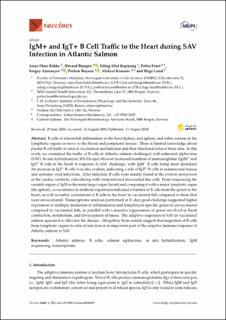| dc.description.abstract | B cells of teleost fish differentiate in the head kidney, and spleen, and either remain in the lymphatic organs or move to the blood and peripheral tissues. There is limited knowledge about piscine B cell traffic to sites of vaccination and infection and their functional roles at these sites. In this work, we examined the traffic of B cells in Atlantic salmon challenged with salmonid alphavirus (SAV). In situ hybridization (RNAScope) showed increased numbers of immunoglobin (Ig)M+ and IgT+ B cells in the heart in response to SAV challenge, with IgM+ B cells being most abundant. An increase in IgT+ B cells was also evident, indicating a role of IgT+ B cells in nonmucosal tissues and systemic viral infections. After infection, B cells were mainly found in the stratum spongiosum of the cardiac ventricle, colocalizing with virus-infected myocardial-like cells. From sequencing the variable region of IgM in the main target organ (heart) and comparing it with a major lymphatic organ (the spleen), co-occurrence in antibody repertoires indicated a transfer of B cells from the spleen to the heart, as well as earlier recruitment of B cells to the heart in vaccinated fish compared to those that were unvaccinated. Transcriptome analyses performed at 21 days post-challenge suggested higher expression of multiple mediators of inflammation and lymphocyte-specific genes in unvaccinated compared to vaccinated fish, in parallel with a massive suppression of genes involved in heart contraction, metabolism, and development of tissue. The adaptive responses to SAV in vaccinated salmon appeared to alleviate the disease. Altogether, these results suggest that migration of B cells from lymphatic organs to sites of infection is an important part of the adaptive immune response of Atlantic salmon to SAV. | en_US |

